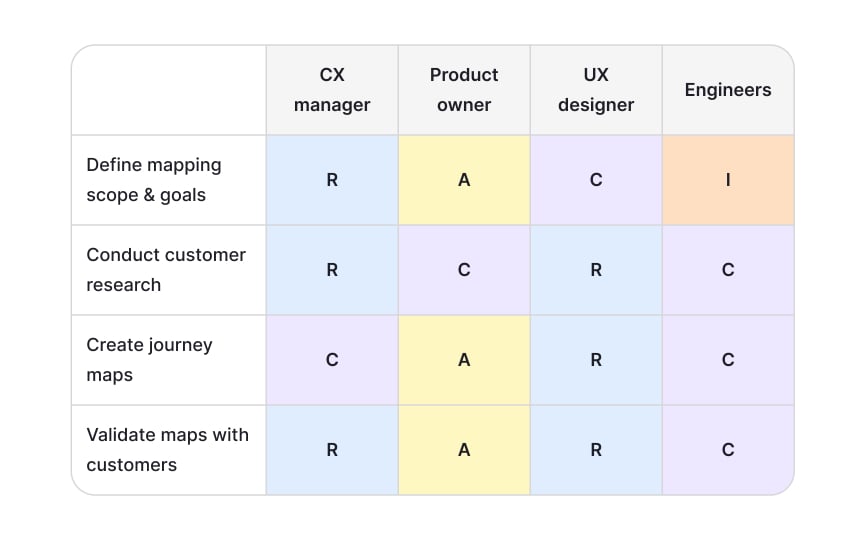Building a Mapping Culture
Transform customer journey mapping from a project into an organizational mindset that drives continuous improvement
Creating a mapping culture transforms customer journey mapping from a one-time activity into an organizational capability. It starts with teaching colleagues from different departments to observe, document, and analyze customer interactions. Success requires identifying champions who advocate for the practice and establishing clear ownership of mapping initiatives. Organizations can assess their mapping maturity by evaluating how consistently teams use journey maps in decision-making, how often they update their maps, and whether mapping insights directly influence product development.
The most sustainable mapping cultures develop through repeated practices: regular mapping sessions, shared templates that ensure consistency, and team habits that make customer perspectives a natural part of every discussion. When mapping becomes embedded in how teams think and work, it shifts from being a special project to becoming the standard way of understanding and improving customer experiences.
Start by demonstrating value through small wins. Use
Make mapping accessible by removing jargon and focusing on customer stories. Replace technical terms with plain language that anyone can understand. Share insights through narratives and visuals that connect emotionally with stakeholders across all levels of the organization.
Teaching
Structure training around real scenarios from team members' daily work. Sales teams can map their customer's buying journey. Support staff can document common problem resolution paths. Using familiar contexts helps non-designers see immediate applications for mapping skills and increases retention of key concepts.
Pro Tip: Run 90-minute workshops focused on mapping one specific touchpoint rather than attempting to cover entire journeys in a single session.
Champions drive cultural change by advocating for
Equip champions with resources to spread mapping practices. Provide presentation templates they can customize for their audiences. Share success stories they can reference. Give them access to customer research and journey data. Create a community where champions can exchange experiences and learn from each other's approaches.
Recognize and celebrate champion contributions publicly. Feature their mapping projects in company communications. Invite them to present successes to leadership. Create formal roles like "Customer Experience Ambassador" to legitimize their efforts. Recognition motivates continued advocacy and attracts new champions to emerge.
Clear ownership structures prevent
Consider different ownership models based on organizational structure:
- Centralized models work when a dedicated
customer experience team exists - Distributed models succeed when departments own their portion of the journey
- Hybrid approaches combine central coordination with departmental ownership
Choose the model that aligns with how your organization makes decisions. Use RACI matrices to clarify who is Responsible for doing the work, Accountable for outcomes, Consulted for input, and Informed of progress. This framework eliminates confusion about roles and ensures every mapping task has clear ownership.[2]
Document ownership responsibilities in detail. Specify update frequencies, quality standards, and escalation paths. Create service level agreements between teams sharing journey touchpoints. Regular ownership reviews ensure accountability remains clear as organizations evolve and team structures change over time.
Measuring mapping maturity helps organizations understand their current capabilities and plan improvements. Basic maturity shows in occasional mapping projects with limited scope. Advanced maturity appears when mapping influences strategic decisions and drives continuous improvement. Most organizations progress through predictable stages as their practice develops.
Evaluate maturity across multiple dimensions:
- Assess how frequently teams create and update maps
- Measure whether mapping insights influence product decisions
- Check if customer journey thinking appears in planning documents
- Review how well different departments collaborate on mapping
initiatives
Use maturity assessments to guide investment priorities:
- Low maturity organizations need basic training and simple tools
- Medium maturity groups benefit from advanced techniques and integration support
- High maturity teams require innovation frameworks and measurement systems
Match resources to actual needs for maximum impact.
Sustainable mapping cultures develop through consistent practices, not one-time
Integrate mapping into existing workflows rather than treating it as extra work. For example:
- Include journey considerations in project kickoffs
- Add customer impact assessment to decision frameworks
- Make journey maps required artifacts for major initiatives
When mapping becomes part of standard processes, it stops being optional and starts being operational.
Design habits that reinforce customer-centric thinking daily:
- Start meetings with customer feedback
- Display journey maps prominently in workspaces
- Include mapping metrics in team dashboards
- Share weekly customer stories across departments
- Small, repeated actions create lasting cultural change more effectively than grand gestures
Effective templates make
Design templates for different purposes and audiences. Create simple versions for quick mapping sessions. Develop detailed templates for comprehensive journey analysis. Build specialized versions for specific departments or journey stages. Consider digital and physical formats to support various working styles. Test templates with real teams before widespread deployment.
Maintain template libraries that evolve with organizational needs. Collect feedback on what works and what frustrates users. Update templates based on successful mapping sessions. Archive outdated versions while preserving useful elements. Share template updates regularly so teams always have access to best current practices.
Remember, there’s no single right or wrong way to template a journey. What matters is what works for your product, service, resources, maturity, and strategy.
Pro Tip: Include example entries in templates to show the level of detail expected and reduce blank page anxiety.
Similar lessons

What is Journey Mapping?

Types of Journey Maps


















